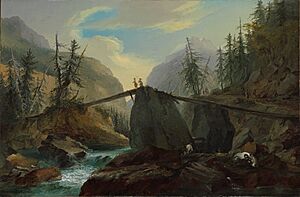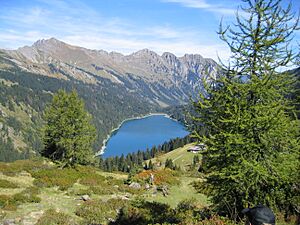Gsteig bei Gstaad facts for kids
Quick facts for kids
Gsteig bei Gstaad
|
||
|---|---|---|
 |
||
|
||
| Country | Switzerland | |
| Canton | Bern | |
| District | Obersimmental-Saanen | |
| Area | ||
| • Total | 62.41 km2 (24.10 sq mi) | |
| Elevation | 1,184 m (3,885 ft) | |
| Population
(Dec 2020 )
|
||
| • Total | 981 | |
| • Density | 15.719/km2 (40.711/sq mi) | |
| Postal code |
3785
|
|
| Surrounded by | Château-d'Œx (VD), Lauenen, Ormont-Dessus (VD), Saanen, Savièse (VS) | |
Gsteig bei Gstaad is a small town in Switzerland. It's located in the Bern area, specifically in the Obersimmental-Saanen district. Gsteig was once known by its French name, Châtelet.
Contents
History of Gsteig
Gsteig is a very old place! It was first mentioned in records in 1312 as Chastelet. Later, in 1453, it was called Steig.
The villages of Gsteig and Feutersoey grew up along important roads. These roads led over mountain passes like the Col du Pillon and the Sanetsch Pass. During the Middle Ages, a castle was built in the valley. Its job was to protect and control these important mountain routes. This castle was first mentioned in 1458, but today it is just ruins.
Long ago, there was another settlement called Ussers Gründ. Sadly, it was destroyed by a landslide. Gsteig was originally part of a larger area called Saanen. The village church, St. Theodul, was built in 1453. It became a branch church of Saanen in 1500. In the early 1500s, the area of Bern changed its religion to Protestantism. Gsteig followed this change in 1556.
For a long time, people in Gsteig mainly raised animals and farmed. They moved their animals to different pastures depending on the season, a practice called seasonal alpine herding. They also earned some money from trade that passed through the mountains. Around 1900, something new became very important: tourism! Today, Gsteig has many hotels and vacation homes. People visit to see places like the Diablerets Glacier, the old castle ruins, the beautiful Arnensee lake, and the nature area at Oldenhorn.
Geography and Nature
Gsteig bei Gstaad covers an area of about 62.44 square kilometers (24.11 square miles). A large part of this land, about 37.1%, is used for farming. Another big part, 36.2%, is covered by forests. Only a small portion, 1.4%, has buildings or roads. About 1.2% of the area is rivers or lakes, and 24.0% is land that can't be used for farming or building, like rocky areas.
The town is located in a valley of the Saane river, in a region called the Bernese Oberland. Gsteig includes the main villages of Gsteig and Feutersoey. There are also many farms spread out in the area. The road to the Col du Pillon, a famous mountain pass, goes through both villages. Near this pass is a place called Reusch, where you can take a cable car up to the Scex Rouge mountain.
A beautiful lake called Arnensee is also found in the municipality. It's actually a reservoir, which means it's a lake created to store water.
Gsteig's Coat of Arms
The coat of arms for Gsteig bei Gstaad is quite interesting! It shows a crane bird flying upwards. The crane is silver with a golden beak and legs. It stands on three silver hills. This image is combined with a blue shield that has a golden tower with battlements.
People of Gsteig
Gsteig bei Gstaad has a population of about 970 people (as of 2011). About 13% of the people living here are from other countries.
Most people in Gsteig speak German as their main language. About 93.2% of the population speaks German. French is the second most common language, spoken by about 2.2% of the people. English is spoken by about 1.1%. A few people also speak Italian or Romansh.
As of 2011, young people (ages 0–19) make up about 19.1% of the population. Adults (ages 20–64) are the largest group, at 63.9%. Seniors (over 64 years old) make up 17% of the population.
Important Buildings and Sites
Two farmhouses in Gsteig are very special! The farm house at Saali 594 and the farm house in Feutersoey at Zelg 408 are listed as important heritage sites of national significance. This means they are protected because of their historical and cultural value. The entire village of Gsteig is also part of the Inventory of Swiss Heritage Sites, which recognizes its importance as a traditional Swiss village.
Economy and Jobs
In 2011, Gsteig bei Gstaad had a low unemployment rate of 1.05%. This means most people who wanted to work had jobs.
In 2008, there were 350 people working in the town.
- About 133 people worked in the primary sector, which includes farming and forestry.
- About 73 people worked in the secondary sector, which includes manufacturing and construction.
- About 144 people worked in the tertiary sector, which includes services like hotels, restaurants, and shops.
Many people who live in Gsteig also work there. In 2000, about 80.7% of the workers lived and worked in the municipality. Most people (62.3%) used a private car to get to work, while some (8.7%) used public transportation.
Religion in Gsteig
According to a census in 2000, most people in Gsteig belong to the Swiss Reformed Church, about 80.9%. About 8.9% of the people are Roman Catholic. There are also smaller numbers of people who follow other Christian churches or are Muslim. Some people do not belong to any church.
Education for Kids
In Gsteig bei Gstaad, many people have completed higher education. About 54.2% of the population has finished upper secondary education, and 8.2% have gone on to university or other higher schools.
The school system in the Canton of Bern works like this:
- One year of optional Kindergarten.
- Six years of Primary school.
- Three years of required lower Secondary school. Students are grouped by their abilities.
After lower Secondary, students can continue their schooling or start an apprenticeship to learn a trade.
During the 2011–2012 school year, 71 students attended schools in Gsteig bei Gstaad.
- There was one kindergarten class with 7 students.
- There were two primary classes with 54 students.
- There was one lower secondary class with 10 students.
Most students who live in Gsteig also go to school there. In 2000, 95 students lived and attended school in the municipality.
Images for kids
See also
 In Spanish: Gsteig bei Gstaad para niños
In Spanish: Gsteig bei Gstaad para niños








